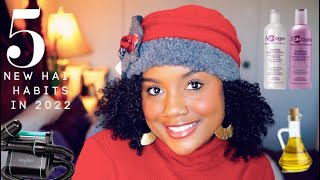How To Wash And Care For High Porosity Hair After Box Braids

Box braids are one of the most popular protective styles for a number of reasons: they’re cute, easy to style, protective, and you can rock them for months with little maintenance. The most difficult part about box braids is the take down; you spend hours unlatching and unraveling hair from your scalp only to spend an additional hour washing and prepping your hair for everyday styling.
It’s a tedious process but perhaps the most important part because if you don’t properly care for your hair after box braids, you will experience unnecessary dryness, breakage, and shedding–ultimately missing out on all of the benefits of protective styling!
In addition, those of you with high porosity hair need to be extra careful when caring for hair after box braids because your kinks, curls, and coils are fragile and far more susceptible to damage. It sounds a little bit risky and time-consuming, but I promise that if you take your time and truly work through the steps, your hair will be perfectly fine.
Below are a few steps you can take to properly wash and care for high porosity hair after taking down your box braids.
Saturate Hair With Oil and Finger Detangle
If your hair is anything like mine, you will definitely experience dryness and build up after you take down your box braids. Whether it is from sweat and improper/no washing or product collecting on your scalp, there’s a good chance you’ll have some buildup after months of wearing braids.
To break down the build up and combat some of that dryness, spritz your hair with a little water and then drizzle or rub oil on your roots and scalp–focusing more on the parts where you have build up. Work the oil through your hair and gently detangle with your fingers.
When I detangle, I use a mixture of heavy oils* and light oils* (like JBCO* and grapeseed oil*) because the heavier oil coats the hair while the lighter oil has more “slip” and makes it easier to work my fingers through my hair and detangle. It also helps to break down and remove any build up that you may have.
Shampoo with warm water, rinses with cool water
Gently rub shampoo through your hair and work it in with warm water. It’s important that the water is warm because the steam will combat any clogged pores your scalp has; on the other hand, hot water is not ideal because it will remove all of the oils you just put in your hair–resulting in drying.
After you’re done shampooing, rinse your hair with cold water to seal the cuticles and preserve the oils in your hair. Make sure not to skip this step; you need to keep your hair as hydrated as possible, and rinsing with hot water will only further dry out your hair.
Use a protein treatment, then deep condition
High porosity hair is fragile enough on its own, but can experience a lot more shedding and breakage after being braided up for so long. Apply a protein treatment like ApHogee 2 Step Treatment or Palmers Coconut Deep Conditioning* Protein Pack to strengthen and define your curls.
If you use a protein treatment that comes in the form of a hair mask and already has hydrating and/or conditioning properties, you may be able to skip deep conditioning*. However, the protein itself is absolutely drying and definitely not a moisturizer, so you should probably still deep condition just to be safe.
Because high porosity hair needs all the moisture it can get, heat the deep conditioner* up and let it sit on your hair for the maximum recommended time for the best results. If you’re afraid to heat the product, wrap a warm towel around your head or blow dry your hair while wearing a protective cap before you rinse everything out.
Moisturize and seal
By this point, you have to be tired of both the action and the word “moisturizing”! I know you have to do a lot of it but constantly moisturizing your hair is a MUST, due to your hair’s slightly raised and/or chipped cuticles. And chances are, your hair didn’t get all the moisture it needed when it was in box braids.
Coat your hair with whatever moisturizer you’d like, but make sure that the sealant is heavy and effective. The key to healthy high porosity hair is retaining moisture so you’ll want a butter or oil that is going to penetrate the hair shaft and keep the moisture in. Some good examples of an effective sealant are olive oil*, shea butter*, avocado oil*, and coconut oil*.
This is the most important–and ongoing–part of the routine because high porosity dries quickly and is often unable to retain moisture. Make sure you are constantly feeding your hair with natural products that will keep it soft, defined, and hydrated.




